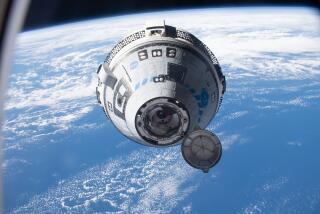Across Sands of Time and Oceans of Space
- Share via
The American spirit has never been shackled by boundaries, and there is no reason that it should be now. With continued American leadership in space, we can expand exploration and provide the American public with significant benefits derived from space research and technology.
To turn back on such promise because of setbacks should not be the option we choose.
Inevitably, after the tragic accident that destroyed the space shuttle Columbia, some voices began calling for halting future shuttle missions. Such a course would preclude the completion of the International Space Station’s laboratories. Who knows what breakthroughs we would miss out on if we took a timid path to the future?
NASA is working to achieve a much more hopeful option.
Our plan is to correct the problems that caused the tragic loss of Columbia and its crew and to continue space shuttle operations once we are deemed fit to fly. This will enable us to complete the construction of the U.S. core laboratory elements on the International Space Station, and to keep alive research that will advance technology, medical science and space travel. Our plan also anticipates developing a bridge to the future, in the form of a next-generation space transportation system.
Some critics of the space shuttle program believe that the shuttle orbiters are simply unsafe to fly. Yet the experts on the independent Columbia Accident Investigation Board have soundly contradicted this opinion.
In testimony before the Senate Commerce, Science and Transportation Committee on Sept. 3, the board’s chairman, Adm. Harold Gehman, said, “The board does not believe that the space shuttle is inherently unsafe, and we were under no pressure to say that it was safe.”
Though achieving access to space is a difficult task, no matter what launch vehicle is used, the facts are that the space shuttle is currently the most reliable and flexible reusable space vehicle in the world today.
The accident investigation board has offered 29 recommendations for improving shuttle safety, 15 of which are mandatory for returning to flight operations. It has called for the creation of an independent system of checks and balances in the shuttle program. Today our entire NASA team is working diligently to implement all of the board’s recommendations and to set the safety bar even higher. In fact, NASA plans to exceed the recommendations of the board by instituting an independent safety and engineering authority at all of our centers, not just for the shuttle program.
The first 100 years of powered flight have taught us how much American ingenuity can accomplish. By continuing to make use of the unique capabilities of the space shuttle in the context of a balanced and forward-looking space program, we refuse to abandon the promise of exploration and innovation in the next century of flight.
More to Read
Sign up for Essential California
The most important California stories and recommendations in your inbox every morning.
You may occasionally receive promotional content from the Los Angeles Times.










